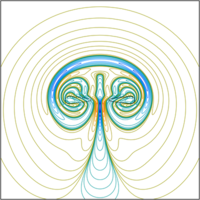当前位置:
X-MOL 学术
›
Phys. Rev. Fluids
›
论文详情
Our official English website, www.x-mol.net, welcomes your
feedback! (Note: you will need to create a separate account there.)
Linear two-dimensional stability of a Lamb-Oseen dipole as an aircraft wake model
Physical Review Fluids ( IF 2.5 ) Pub Date : 2020-01-24 , DOI: 10.1103/physrevfluids.5.014701 Rémi Jugier , Jérôme Fontane , Laurent Joly , Pierre Brancher
Physical Review Fluids ( IF 2.5 ) Pub Date : 2020-01-24 , DOI: 10.1103/physrevfluids.5.014701 Rémi Jugier , Jérôme Fontane , Laurent Joly , Pierre Brancher

|
The dynamics of perturbed aircraft wake models is investigated in the two-dimensional limit by means of a linear stability analysis. The base flow, computed by a direct numerical simulation of the incompressible Navier-Stokes equations, is a viscous counter-rotating vortex dipole obtained from an initial condition which is either a superposition of two Lamb-Oseen vortices or a vorticity sheet with elliptical vorticity distribution. The former, referred to as the Lamb-Oseen dipole (LOD), is a model for the far field of the wake and gives rise to a family of quasisteady dipoles parametrized by their aspect ratio only. The later approaches the near-field wake of a wing during the rolling phase which eventually converges towards the LOD model at later times. First, a modal stability analysis of the LOD under the assumption of a frozen base flow is performed for aspect ratios ranging from 0.05 to 0.36 at various Reynolds numbers. Several families of unstable antisymmetric and symmetric modes are observed. The maximal growth rates are reached at low Reynolds numbers. The results are consistent with those obtained by Brion et al. [Phys. Fluids 26, 064103 (2014)] for the higher aspect ratio inviscid Lamb-Chaplygin dipole (LCD). However, the a posteriori verification of the validity of the frozen base flow assumption shows that, except for a few modes occurring at the highest aspect ratios and large Reynolds numbers, these two-dimensional instabilities do not survive the base flow unsteadiness due to viscous diffusion. They are thus not likely to develop in the flow. Second, we focus on the transient dynamics of the dipoles by looking for the optimal perturbations through a nonmodal stability analysis based on a direct-adjoint approach. The observed energy gains are substantial and indicate the potential of transient mechanisms. In the short time dynamics, the optimal perturbation consists of intertwined vorticity layers located within each vortex core and leading to a deformation Kelvin wave excited by the Orr mechanism. For moderate to large horizon times, the optimal perturbation takes the form of vorticity layers localized outside the vortex core which eventually give rise to the two-dimensional unstable mode unveiled by the modal analysis through a combination of Orr mechanism and velocity induction. The robustness of these modes is examined by considering the initial stage of the development of aircraft wakes. The optimal perturbations developing on an elliptic and a double-elliptic vorticity sheet present a similar structure and rely on the same mechanisms as the ones observed for the LOD but come with lower energy gains. It is concluded that the rolling-up of the vorticity sheet in the near-field of the wake does not influence significantly the linear development of these two-dimensional perturbations.
中文翻译:

Lamb-Oseen偶极子作为飞机尾迹模型的线性二维稳定性
通过线性稳定性分析,在二维极限范围内研究了扰动飞机尾流模型的动力学。通过不可压缩的Navier-Stokes方程的直接数值模拟计算得出的基流是从初始条件获得的粘性反向旋转涡流偶极子,该初始条件可以是两个Lamb-Oseen涡旋的叠加,也可以是具有椭圆形涡旋分布的涡旋片。前者被称为Lamb-Oseen偶极子(LOD),是尾流远场的模型,并产生了仅由其长宽比参数化的准稳态偶极子族。后者在滚动阶段接近机翼的近场尾流,最终在稍后的时间向LOD模型收敛。第一,雷诺数在0.05到0.36之间。观察到几类不稳定的反对称和对称模式。在低雷诺数下达到最大的增长率。结果与Brion等人获得的结果一致。[物理 流体 26,064103(2014)]表示高粘度比的Lamb-Chaplygin偶极子(LCD)。但是,对冻结基流假设的有效性进行的后验验证表明,除了在最高长宽比和大雷诺数下出现的几种模式之外,这些二维不稳定性不能幸免于由于粘性扩散引起的基流不稳定。因此,它们不太可能在流程中发展。其次,我们通过基于直接伴随方法的非模态稳定性分析寻找最佳扰动,从而关注偶极子的瞬态动力学。观察到的能量增益是巨大的,并且表明了瞬态机制的潜力。在短时动力学中,最佳扰动由位于每个涡流核心内的相互缠绕的涡度层组成,并导致变形开尔文波由奥尔机制激发。对于中等到较大的视界时间,最佳扰动采取位于涡流核心外部的涡旋层的形式,这最终导致了二维模态的不稳定模式,该模态是通过Orr机理和速度感应的组合进行模态分析揭示的。这些模式的鲁棒性是通过考虑飞机尾波发展的初始阶段来检验的。在椭圆形和双椭圆形涡旋片上形成的最佳扰动具有相似的结构,并且依赖于与对LOD观察到的相同的机制,但具有较低的能量增益。结论是,涡流片在尾流的近场中的卷积不会显着影响这些二维扰动的线性发展。
更新日期:2020-01-24
中文翻译:

Lamb-Oseen偶极子作为飞机尾迹模型的线性二维稳定性
通过线性稳定性分析,在二维极限范围内研究了扰动飞机尾流模型的动力学。通过不可压缩的Navier-Stokes方程的直接数值模拟计算得出的基流是从初始条件获得的粘性反向旋转涡流偶极子,该初始条件可以是两个Lamb-Oseen涡旋的叠加,也可以是具有椭圆形涡旋分布的涡旋片。前者被称为Lamb-Oseen偶极子(LOD),是尾流远场的模型,并产生了仅由其长宽比参数化的准稳态偶极子族。后者在滚动阶段接近机翼的近场尾流,最终在稍后的时间向LOD模型收敛。第一,雷诺数在0.05到0.36之间。观察到几类不稳定的反对称和对称模式。在低雷诺数下达到最大的增长率。结果与Brion等人获得的结果一致。[物理 流体 26,064103(2014)]表示高粘度比的Lamb-Chaplygin偶极子(LCD)。但是,对冻结基流假设的有效性进行的后验验证表明,除了在最高长宽比和大雷诺数下出现的几种模式之外,这些二维不稳定性不能幸免于由于粘性扩散引起的基流不稳定。因此,它们不太可能在流程中发展。其次,我们通过基于直接伴随方法的非模态稳定性分析寻找最佳扰动,从而关注偶极子的瞬态动力学。观察到的能量增益是巨大的,并且表明了瞬态机制的潜力。在短时动力学中,最佳扰动由位于每个涡流核心内的相互缠绕的涡度层组成,并导致变形开尔文波由奥尔机制激发。对于中等到较大的视界时间,最佳扰动采取位于涡流核心外部的涡旋层的形式,这最终导致了二维模态的不稳定模式,该模态是通过Orr机理和速度感应的组合进行模态分析揭示的。这些模式的鲁棒性是通过考虑飞机尾波发展的初始阶段来检验的。在椭圆形和双椭圆形涡旋片上形成的最佳扰动具有相似的结构,并且依赖于与对LOD观察到的相同的机制,但具有较低的能量增益。结论是,涡流片在尾流的近场中的卷积不会显着影响这些二维扰动的线性发展。











































 京公网安备 11010802027423号
京公网安备 11010802027423号